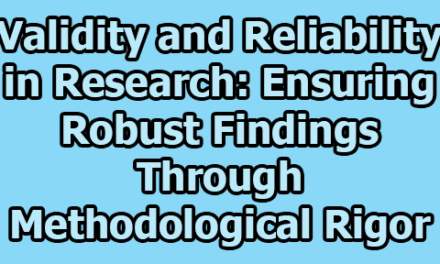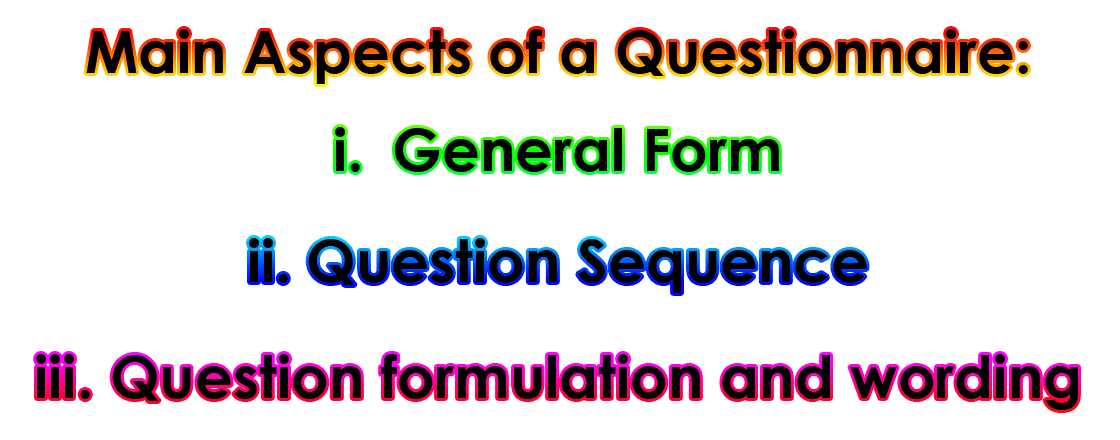Hypotheses bring clarity, specificity, and focus to a research problem. It is not essential for a study and one can conduct a valid investigation without constructing a formal hypothesis. On the other hand, within the context of a research study, we can construct as many hypotheses as we consider to be appropriate. Hypotheses primarily arise from a set of ‘hunches’ that are tested through a study and one can conduct a perfectly valid study without having these hunches or speculations. Hypotheses are based upon similar logic. As a researcher, we do not know about a phenomenon, a situation, the prevalence of a condition in a population, or the outcome of a program, but we do have a hunch to form the basis of certain assumptions or guesses. We test these, mostly one by one, by collecting information that will enable us to conclude if our hunch was right. The verification process can have one of three outcomes. Our hunch may prove to be: right, partially right, or wrong. Without this process of verification, we cannot conclude anything about the validity of our assumption. In the rest of the article, we are going to present to you definitions, functions, characteristics, types, errors & the process of testing a hypothesis, and hypotheses in qualitative research.
Definitions of Hypothesis:
A hypothesis is a hunch, assumption, suspicion, assertion, or an idea about a phenomenon, relationship, or situation, the reality or truth of which we do not know.
A researcher calls these assumptions, assertions, statements, or hunches hypotheses and they become the basis of an inquiry.
In most studies, the hypothesis will be based upon either previous studies or our own or someone else’s observations.
“A hypothesis is a conjectural statement of the relationship between two or more variables.” (Kerlinger, 1986)
Black and Champion define a hypothesis as “a tentative statement about something, the validity of which is usually unknown”
Bailey defines a hypothesis as; a proposition that is stated in a testable form and that predicts a particular relationship between two (or more) variables.
“A hypothesis is written in such a way that it can be proven or disproven by valid and reliable data – it is in order to obtain these data that we perform our study.” (Grinnell, 2013)
From the above definitions it is apparent that a hypothesis has certain characteristics:
- It is a tentative proposition.
- Its validity is unknown.
- In most cases, it specifies a relationship between two or more variables.
Functions of a Hypothesis:
A hypothesis is important in terms of bringing clarity to the research problem. Specifically, a hypothesis serves the following functions:
- A hypothesis provides a study with focus. It tells us what specific aspects of a research problem to investigate.
- It tells us what data to collect and what not to collect, thereby providing focus to the study.
- As it provides a focus, the construction of a hypothesis enhances objectivity.
- A hypothesis may enable us to add to the formulation of the theory. It enables us to conclude specifically what is true or what is false.
Characteristics of a Hypothesis:
There are a number of considerations to keep in mind when constructing a hypothesis. The wording of a hypothesis must have certain attributes that make it easier for us to ascertain its validity. These attributes are:
- A hypothesis should be simple, specific, and conceptually clear. There is no place for ambiguity in the construction of a hypothesis, as ambiguity will make the verification of a hypothesis almost impossible.
- It should be ‘unidimensional’ – that is, it should test only one relationship or hunch at a time.
- To be able to develop a good hypothesis we must be familiar with the subject area. The more insight we have into a problem, the easier it is to construct a hypothesis.
For example; the average age of the male students in this class is higher than that of the female students. The above hypothesis is clear, specific, and easy to test. It tells us what we are attempting to compare (average age of this class), which population groups are being compared (female and male students), and what we want to establish (higher average age of the male students).
Let us take another example; suicide rates vary inversely with social cohesion. (Black & Champion 1976) This hypothesis is clear and specific, but a lot more difficult to test. There are three aspects of this hypothesis: ‘suicide rates’; ‘vary inversely’, which stipulates the direction of the relationship; and ‘social cohesion. Finding out the suicide rates and establishing whether the relationship is inverse or otherwise are comparatively easy, but ascertaining social cohesion is a lot more difficult. What determines social cohesion? How can it be measured? This problem makes it difficult to test this hypothesis.
- A hypothesis should be capable of verification. Methods and techniques must be available for data collection and analysis.
- A hypothesis should be related to the existing body of knowledge.
- It is important that our hypothesis emerges from the existing body of knowledge, and that it adds to it, as this is an important function of research.
- This can only be achieved if the hypothesis has its roots in the existing body of knowledge.
- A hypothesis should be operationalizable. This means that it can be expressed in terms that can be measured. If it cannot be measured, it cannot be tested and, hence, no conclusions can be drawn.
Types of Hypothesis:
Theoretically, there should be only one type of hypothesis which is the research hypothesis – the basis of our investigation. However, because of the conventions in scientific inquiries and because of the wording used in the construction of a hypothesis, hypotheses can be classified into several types. Broadly, there are two categories of hypotheses: Research hypotheses and Alternate hypotheses.
Formulation of an alternate hypothesis is a convention in scientific circles. Its function is to explicitly specify the relationship that will be considered as true in case the research hypothesis proves to be wrong. An alternate hypothesis is the opposite of the research hypothesis. Conventionally, a null hypothesis, or hypothesis of no difference, is formulated as an alternate hypothesis.
Let us take an example; suppose we want to test the effect that different combinations of maternal and child health services (MCH) and nutritional supplements (NS) have on the infant mortality rate. To test this, a two-by-two factorial experimental design is adopted.
The second hypothesis in each example implies that there is a difference either in the extent of the impact of different treatment modalities on infant mortality or in the proportion of male and female smokers among the population, though the extent of the difference is not specified. A hypothesis in which a researcher stipulates that there will be a difference but does not specify its magnitude is called a hypothesis of difference.
Let us take an example; suppose we want to study the smoking pattern in a community in relation to gender differentials. The following hypotheses could be constructed:
- There is no significant difference in the proportion of male and female smokers in the study population.
- A greater proportion of females than males are smokers in the study population.
- A total of 60 percent of females and 30 percent of males in the study population are smokers.
- There are twice as many female smokers as male smokers in the study population.
In the examples, the way the first hypothesis has been formulated indicates that there is no difference either in the extent of the impact of different treatment modalities on the infant mortality rate or in the proportion of male and female smokers.
When we construct a hypothesis stipulating that there is no difference between two situations, groups, outcomes, or the prevalence of a condition or phenomenon, this is called a null hypothesis and is usually written as H0.
The Process of Testing a Hypothesis:
To test a hypothesis, we need to go through a process that comprises three phases:
- Constructing a hypothesis;
- Gathering appropriate evidence; and
- Analyzing evidence to draw conclusions as to its validity.
It is only after analyzing the evidence that we can conclude whether our hunch or hypothesis was true or false. In conclusion, we specifically make a statement about the correctness or otherwise of a hypothesis in the form of ‘the hypothesis is true or ‘the hypothesis is false’. It is, therefore, imperative that we formulate our hypotheses clearly, precisely, and in a form that is testable. In making a conclusion about the validity of a hypothesis, the way we collect our evidence is of central importance and it is therefore essential that our study design, sample, data collection method(s), data analysis and conclusions, and communication of the conclusions be valid, appropriate and free from any bias.
Errors in Testing a Hypothesis:
As already mentioned, a hypothesis is an assumption that may prove to be either correct or incorrect. It is possible to arrive at an incorrect conclusion about a hypothesis for a variety of reasons. Incorrect conclusions about the validity of a hypothesis may be drawn if:
- The study design selected is faulty;
- The sampling procedure adopted is faulty;
- The method of data collection is inaccurate;
- The analysis is wrong;
- The statistical procedures applied are inappropriate; or
- The conclusions drawn are incorrect.
Any, some or all of these aspects of the research process could be responsible for the inadvertent introduction of error in a study, making conclusions misleading. Hence, in the testing hypothesis, there is always the possibility of errors attributable to the reasons identified above. In drawing conclusions about a hypothesis, two types of error can occur:
- Rejection of a null hypothesis when it is true. This is known as a Type I error.
- Acceptance of a null hypothesis when it is false. This is known as a Type II error.
Hypotheses in Qualitative Research:
- One of the differences in qualitative and quantitative research is around the importance attached to and the extent of use of hypotheses in undertaking a study.
- As qualitative studies pay emphasis on describing, understanding, and exploring phenomena using categorical and subjective measurement procedures, the construction of hypotheses is neither advocated nor practiced.
- In addition, as the degree of specificity needed to test a hypothesis is deliberately not adhered to in qualitative research, the testing of a hypothesis becomes difficult and meaningless.
- It does not mean that we cannot construct hypotheses in qualitative research; the non-specificity of the problem as well as methods and procedures make the convention of hypotheses formulation far less practicable and advisable.
- Even within quantitative studies, the importance attached to and the practice of formulating hypotheses vary markedly from one academic discipline to another.
- In social sciences, the formulation of hypotheses is mostly dependent on the researcher and the academic discipline, whereas within an academic discipline it varies markedly between the quantitative and qualitative research paradigms.
References:
- Kerlinger, P., & Lein, M. R. (1986). Differences in Winter Range among age-sex Classes of Snowy Owls Nyctea scandiaca in North America. Ornis Scandinavica (Scandinavian Journal of Ornithology), 17(1), 1–7. https://doi.org/10.2307/3676745
- Black, J. A., & Champion, D. J. (1976). Methods and issues in social research. John Wiley & Sons.
- Bailey, K. D. (2006). Living systems theory and social entropy theory. Systems Research and Behavioral Science: The Official Journal of the International Federation for Systems Research, 23(3), 291-300.
- Grinnell, F. (2013). Research integrity and everyday practice of science. Science and Engineering Ethics, 19(3), 685-701. The Process Testing of a Hypothesis The Process Testing of a Hypothesis The Process Testing of a Hypothesis

Library Lecturer at Nurul Amin Degree College










